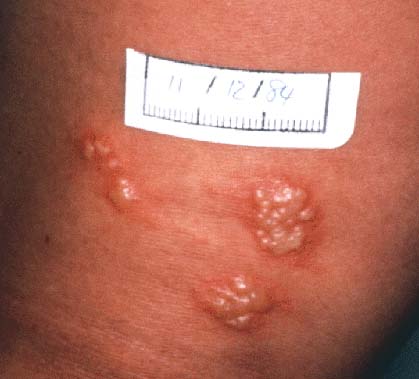|
|
|
Herpes simplex
Herpes simplex, caused by Herpesvirus hominis, is a viral infection of the skin manifested by erythema, vesicles, and crusting. Herpes simplex virus (HSV) type 1 is the usual cause of non-genital herpes simplex infections, while HSV2 is the usual cause of genital infections. However, either type can cause lesions at any body location.
The initial infection with herpes simplex virus, the primary infection, is typically much more severe than subsequent occurrences. Lesions can involve much of the oral mucosa in an extensive herpetic gingivostomatitis. Primary herpes genitalis (HSV2) can produce extensive ulceration.
Recurrent herpes simplex, in the presence of an intact immune system, produces a much more restrained eruption. Typically grouped vesicles are present in a 1 to 2 centimeter diameter circle, with some erythema, vesiculation, and crusting, but without frank ulceration.
There is frequently a prodrome of tingling prior to the eruption being clinically apparent.
Chronic cutaneous herpes simplex can occur in immune compromised individuals, particularly those on systemic immunosuppressive agents. A cutaneous ulcer can slowly expand with some vesiculation and crusting at the border. This expanding lesion is typically painless.
The most common cause of erythema multiforme is a precursor herpes simplex exacerbation. In other words, the erythema multiforme represents a host reaction to the presence of herpes simplex antigen.
Treatment:
- Topical Acyclovir
- Oral Acyclovir
- Idoxuridine
- Valacyclovir
- Famciclovir
- Foscarnet
- Cidofovir

Back to Dermatology Glossary - H Index |
Back to Dermatology Glossary Index
|